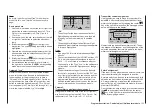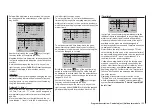
122 Program description - Control adjust | Helicopter models
Control adjust
Basic procedure for transmitter control and switch assignment
This option is available as standard on
both transmitter types.
Use the selection keys on the left or right
four-way button to scroll to the »Control
adjust« option in the multi-function menu:
Servo adjustment
Dual Rate / Expo
Stick mode
Channel 1 curve
Switch display
Control adjust
Open this menu option with a tap on the center
SET
key of the four-way button pad. On the standard
eight-channel
mc-16
HoTT transmitter this looks as
follows:
In5
offset
Thro
Gyro
Lim.
–––
–––
–––
Lv2
0%
0%
0%
0%
GL
GL
GL
GL
typ
fr
fr
fr
–––
SEL
On the
mc-16
HoTT transmitter with twelve chan-
nels unlocked, and on the standard twelve-channel
mc-20
HoTT transmitter, this looks as follows:
In5
offset
0%
0%
0%
Thro
Gyro
In8
–––
–––
–––
In9
In10
In11
Lim.
–––
–––
–––
Lv2
0%
0%
0%
0%
0%
–––
GL
GL
GL
GL
GL
GL
GL
GL
typ
fr
fr
fr
fr
fr
fr
fr
–––
SEL
Note:
To save space the remaining screen-shots in this sec-
tion are based on the display of the standard eight-
channel
mc-16
HoTT transmitter. The pictures also
apply in similar manner to the
mc-16
HoTT trans-
mitter with twelve channels unlocked, and the stand-
ard twelve-channel
mc-20
HoTT transmitter, since
the only difference between the transmitter displays
is the lines “In8” to “In11” located between “Gyro” and
“Lim.”.
Although the basic hardware features of the
mc-16
HoTT and
mc-20
HoTT transmitters are the same,
i. e. two dual-axis sticks for control functions 1 to 4
and the associated trim levers, the standard sup-
plementary controls fitted to the two transmitters are
different.
•
mc-16
HoTT
• two 3-way switches (SW 5/6 & 11/12)
• two proportional sliders on the middle console,
designated Sl 1 & 2 in the menu
• two side-mounted “rotary sliders”, designated
Lv1 and 2 in the menu
•
mc-20
HoTT
• three 3-way switches (SW 2/3, 5/6 & 11/12)
• five 2-way switches (SW 4, 7, 9, 13 & 15)
• two self-restoring 2-way switches (SW 8 & 14)
• two unlockable 2-way switches (SW 1 & 10)
• two push-buttons on the back-side of the trans-
mitter (SW 16 & 17 bzw. 18 & 19)
• two switch-keys (Gb5 & Gb6)
• two proportional sliders on the middle console,
designated Sl 1 & 2 in the menu
• two side-mounted “rotary sliders”, designated
Lv1 and 2 in the menu
In contrast to the two sticks which, even for a newly
initialized “Helicopter” model type will automatically
use the servos attached to receiver outputs 1 … 4
and 6, the aforementioned “other” operating ele-
ments – except for the standard assignment of servo 6
to the right-side proportional slider, designated in this
menu as Lv2 (throttle limiter) – are initially inactive.
One of the effects of this is that (as already men-
tioned on page 77) with a factory-fresh system – as
with a newly initialized model memory for a “Helicop-
ter” model type following its “binding” to the intended
receiver – only those servos connected to receiver
outputs 1 … 4 and – depending on the position of
the throttle limiter – servo 6 can be moved by the two
sticks. Any servos connected to plug-in locations 5,
7 and 8 or 5, 7 through 12, on the other hand, will
simply remain at their center positions.
While this may appear a bit awkward at first glance
… this is the only way to ensure a completely free
selection from among “additional” operating elements
while, at the same time, not requiring the “deactiva-
tion” of unused operating elements. This is because
the only way to ensure an unused operating ele-
ment can have no effect on the model, even if
operated by accident, is to make it inactive, i. e.
not assigned to any function.
All of the aforementioned operating elements can
be freely assigned in this »Control adjust« menu to
any function input, see page 66, just to accommo-
date personal requirements. Equally, this also means
that each of these operating elements can also be
assigned to multiple functions at the same time, as
needed. For example: the exact same toggle switch
assigned to an input in this menu can, at the same
time, also have an assignment in the »Timers (gen-
eral)« menu as an “On/Off” switch, etc.
Furthermore, all inputs can be selectively set to
global or flight-phase specific operation if they have
been defined for flight-phases in the »Phase set-
tings« menu, page 156, and »Phase assignment«
menu, page 158. The names assigned to given flight
phases then appear in the second-from-the-bottom
display line, e. g. «Normal».
mc
16 20
Summary of Contents for HoTT MC-16 Series
Page 1: ...Programming Manual mc 16 mc 20 HoTT 1 en mc 16 mc 20...
Page 27: ...27 For your notes...
Page 53: ...53 For your notes...
Page 61: ...61 For your notes...
Page 65: ...65 For your notes...
Page 71: ...71 For your notes...
Page 103: ...103 For your notes...
Page 107: ...107 For your notes...
Page 111: ...111 For your notes...
Page 155: ...155 For your notes...
Page 165: ...165 For your notes...
Page 201: ...201 For your notes...
Page 229: ...229 For your notes...
Page 231: ...231 For your notes...
Page 261: ...261 For your notes...
Page 265: ...265 For your notes...
Page 301: ...301 For your notes...
Page 327: ...327 For your notes...
Page 328: ...328 For your notes...
















































